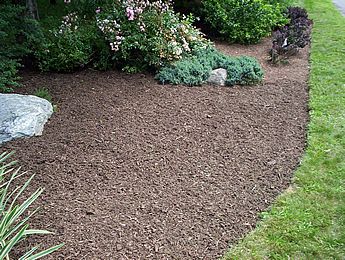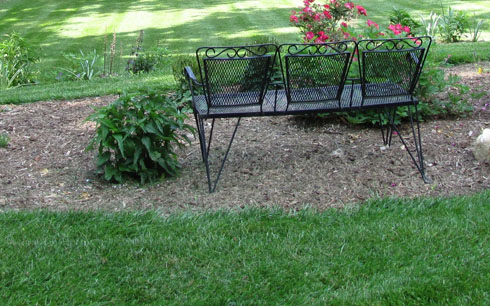Springtime Mulching
Why do we want to Mulch?
Mulching is a practice that trees have been doing all by themselves for thousands of years. Each year, trees drop leaves or needles to the forest floor, forming a layer of organic matter. This layer serves many functions, but first and foremost it provides cover to the soil, reducing or eliminating erosion. This layer of leaves also helps to retain moisture, adds organic material to the root zone of the plant, and allows of recycling of nutrients.

Mulch in the landscape serves the same purpose, and also provides a number of other benefits. First and foremost, just like in the natural landscape, it helps to conserve and maintain soil moisture, which is a huge benefit for plants. In addition, mulch also provides the following benefits:
The dark color of mulch serves to warm the soil, which promotes earlier root growth and earlier spring growth of plants
Mulch helps to delay soil freezing and prevent frost heaving
Mulch protects plants and plant roots from damage by equipment such as mowers and weed eaters
Mulch minimizes compaction from traffic in the mulched area
Mulch helps to suppress competing vegetation such as weeds and grass
By covering the soil with mulch soil erosion is minimized
Mulch slows runoff from rain events and allows moisture to soak into the ground
Mulch enhances garden and landscape appearance
Mulch makes garden and landscape maintenance easier.
Finally, using an organic mulch also adds organic matter to the soil, which serves to improve the soil’s water holding capacity, increases the number of microorganisms in the soil profile, and improves nutrient holding and supply of the soil.
What types of Mulch Are There?
There are two main classes, and several different types within each:
Organic mulches
Inorganic mulches
First, let’s discuss the different types of organic mulches:
These mulches include bark, wood chips, sawdust, pine straw, and lawn clippings, and typically these mulches must be applied at least once per season, and keep in mind that weeds can be an issue with any of these mulches.
Bark: Shredded bark mulches are the most common type of mulch we see, and it is readily available in bags or bulk. Usually made form pine or hardwoods trees in our area. It is resistant to decomposition. Bark mulches provide organic matter to the soil and offer an aesthetically pleasing effect when applied properly.
Wood Chips: Wood chips can be utilized as an organic mulch, but sizes greater than three inches are recommend. This prevents the chips from compacting and forming a very dense layer. Caution must be used, as only fresh chips should be utilized. Chips which have been aged or composted can have products in them that can be toxic to young plants.
Sawdust: Sawdust mulches can be easy to get and can make a nice mulch. However, they often compact and form a mat that needs to be broken up to let water and air to the root zone of mulched plants. It is also important to watch for nitrogen deficiency (when your plants appear light green to yellow colors and slow growth) when using sawdust due to the high carbon to nitrogen ratio.
Lawn Clippings: Lawn clippings can be used as a mulch, but in general it is best to leave clippings on the lawn whenever possible to recycle nutrients in the lawn system. They should also not be utilized if broadleaf weed control products have been applied.
Leaves: Leaves offer an attractive mulch that is very natural in appearance. They should be partially rotted, shredded, and dried before being used, because large leaves that are not rotted can form heavy mats and cause issues with water and air infiltration. They can also trap water underneath; causing a wet environment that fosters decay and fungus. Some leaves such as oak leaves can contribute to acidity and walnut leaves contain compounds which harm many plants, so they should be avoided.
Pine Straw: Pine straw is gaining popularity in our area, and one of the pleasing attributes of pine straw is that the needles do not compact, and they help to add a natural look to garden areas. It is important to remember, however, that pine needles can contribute to the acidity of the soil, so a soil testing program would be a great idea if you are using pine straw.
Inorganic or Permanent Mulches
These include gravel, brick chips, and crushed stone, and typically only need to be applied one time, are often applied over a fabric layer, and then are permanent. Weeds can also be an issue each season in these types of mulches. Typically these types of mulch are recommended where no future planting will be done, and they can make attractive mulch.
However, these products have limited ability to conserve moisture and do not add any organic matter to the soil system or buffer temperatures as well as organic mulches. Also, some crushed stone and gravel products can alter the pH of the soil nearby, so take care when selecting these types of products, and be sure to perform a soil analysis the following season to monitor soil pH.

How to Mulch:
Apply mulches at planting time, and then annually as needed. Prior to applying mulches, weeds should be removed and the area leveled. By edging the area to be mulched, you can keep your mulch where it is supposed to be. In the case of trees, mulch from near the trunk to the drip line, or at least two to three feet out whenever possible. Mulch should not be in contact with the trunk of the tree, and should never be piled up against the tree, as in the case of the often seen mulch volcano. Mulches should be applied 2 to four inches deep.
How Not to Mulch:
Mulch too thin –Mulch that is less than two inches in depth does not serve the purpose of conserving moisture, reducing erosion, or providing any of the other benefits of mulch.
Mulch too close to plant stems or trunks--When mulch is piled against the stems of plants or the trunks of trees, it keeps this tissue too wet, and sets up an environment for insect and diseases to move into the stem or trunk of the covered plant.
Mulch not extended to drip line--Mulching in a small circle around the base of tree will help to protect it from damage, but to give your plants the maximum benefit from mulching, mulch should extend to the drip line of the plant or tree. This covers a large percentage of the roots and helps to conserve moisture, minimize competition from grass, and can offer protection from compaction and damage.
No or poor weed control prior to mulching—Mulch can provide a great environment for your plants, but it can also provide a great environment for weed seeds to germinate and grow. Be sure to remove weeds prior to mulching and during the season. Many weed control options exist, such as mechanical weed control, pre-emergent weed control products that prevent weed seed germination, and post emergent herbicides which can be applied to remove weeds from mulch bed areas.
In summary, one of the best things you can do this spring for your plants is to apply a nice layer of mulch. It will beautify the area, conserve moisture through the season, and will benefit the plant in a number of ways.
About this File
Author: John Freeborn
Release Date: March 15, 2014
Length: 08:06
Link: Springtime Mulching (MP3 | 7MB)
Contact Turf and Garden Tips
Please contact your local Extension office for more information related to your turf and garden questions.


